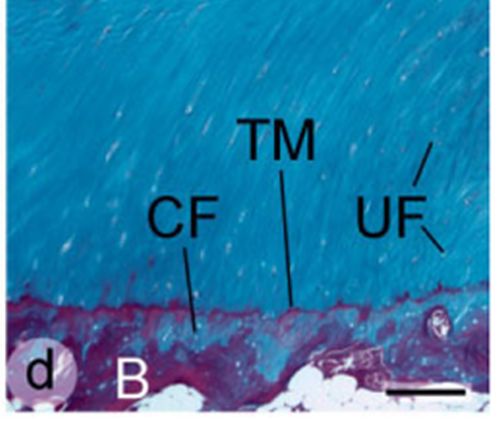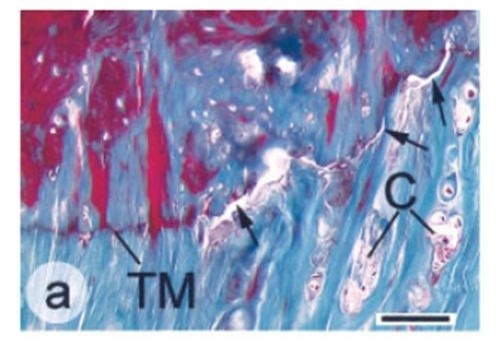Enthesis Bone Microdamage
Introduction
The human skeleton is subject to wear and tear. This leads to microscopic bone fractures or microfractures. These are very small and range from less than one tenth to one half of a millimetre. If not repaired, lots of microfractures can link up in a chain. This can lead to a hairline crack that is termed a stress fracture. The role of the enthesis in microfractures and stress fractures is not fully appreciated and largely unrecognised.
Microfractures at the human Enthesis
The normal enthesis is prone to microfractures because of the very high forces exerted at the fibrocartilage to bone attachment site.

|
| This is a completely normal enthesis bone interface.
UF= uncalcified fibrocartilage
CF= calcified fibrocartilage
TM = tide mark or junction between soft and hard CF tissue
B = bone
|
Microfractures are repaired
Bone microfractures occurring adjacent to the enthesis are usually repaired efficiently. The enthesis tissue at microfracture sites is termed calcified fibrocartilage which lacks a blood supply. However, the adjacent bone has an excellent blood supply. Blood vessels penetrate these sites of damage and lead to repair.
This image shows bone microdamage that is very common in aged normal entheses. [1]

|
| TM= tidemark. The three arrows show 3 microfractures at the tidemark junction where the enthesis changes abruptly from soft tissue to bone. |
Microfractures and age
There is evidence that enthesis microfractures are very uncommon in youth but increase with age. This may relate to the better elasticity of the skeleton in youth that is less prone to microscopic tears or damage [2].
Molecular basis for normal bone repair
This is a highly complex process and is dependent on many cells and molecules including prostaglandins. In AS it is possible that an over exaggerated repair reaction to normal levels of bone microdamage triggers excessive bone formation in the spine. Of note anti-inflammatory drugs taken for pain may also directly block new bone formation.
Implications of Microfractures
The relevance of microfractures at the normal human enthesis was only recently appreciated.
In engineering, stress fractures related to use and fatigue are a major problem. In medicine stress fractures can lead to severe bone pain and even bone breaks.
To what degree enthesis related microfracture non-repair is linked to sports related disorders of the enthesis is unknown and is an area for further research.
References


Resources
e-medicine health Stress fracture